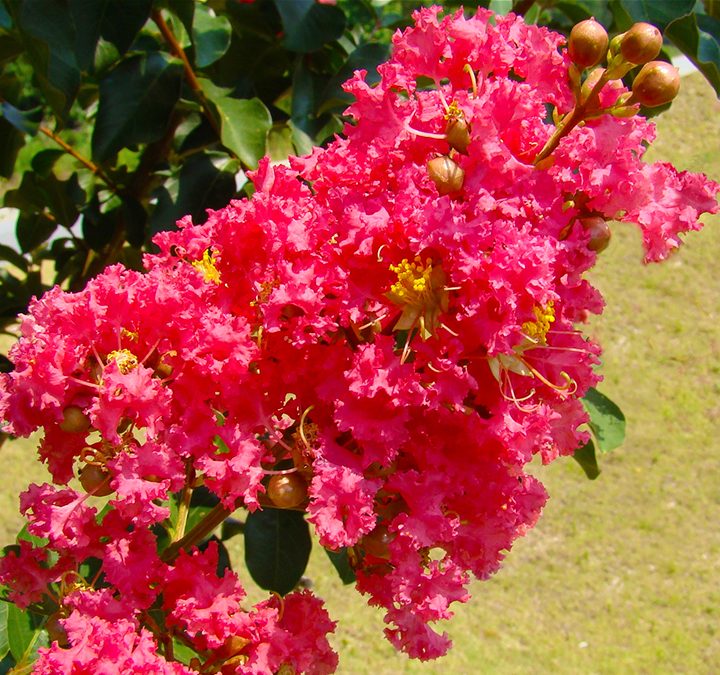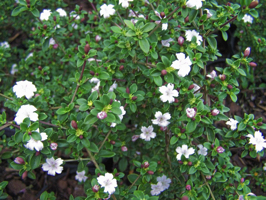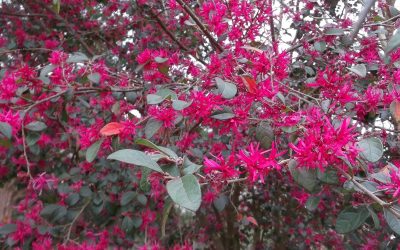Crepe Myrtle Video Tips – Short and Sweet Segment
The crepe myrtle is a hardy, versatile landscape plant. While popularly used as a small flowering tree, new cultivars can be used as ground covers and even as hanging baskets. Most commonly grown as a tree or large shrub, the crepe myrtle gives us a large variety of summer flowers. The Lagerstroemica is native to China and southeastern Asia. It was among the first plants brought to this country and planted first at Middleton Plantation, South Carolina, in the 1740’s.
The crepe myrtle is cold hardy and very drought tolerant once established. The tree should be planted in full sun with good air flow. This will help the plant to avoid insect and powdery mildew problems. It grows best in loamy soil and will not tolerate wet locations. A soil pH of 5.0 to 6.5 will allow the crepe myrtle to grow at its best. The plants do not require a lot of fertilizer. Your trees can be grown with up to four applications per year to stimulate fast growth. Almost any type of general fertilizer will be fine.
A deciduous shrub or tree, the crepe myrtle should be pruned in late fall or winter. Please do not prune the plant hard or low. Severe pruning will produce more leaves but fewer flowers. With the wide range of sizes, you should pick a variety that suits the desired height. Tip pruning to remove old flowers will promote new flowers the same summer.
Seldom fatal, crepe myrtle can be plagued with aphids and powdery mildew. The original variety Indica is more hardy to these problems. Sprays of insecticide soap or horticultural oil are the most environmentally safe pesticides for controlling the crepe myrtle aphid. This will also wash off the black ‘sooty mold’ that results from the aphids. The best way to avoid powdery mildew problems is to plant a cultivar that is resistant to the problem.
Crepe myrtle flowering begins as early as May. These 6-18 inch clusters of flowers can be red, pink, white, lavender or purple,. In fall the leaves turn a brilliant yellow, orange or red before they drop off. The trunks of the trees can be quite attractive ranging from pale cream to dark cinnamon or rich brown in color. In conclusion if you want a hardy, flowering, small tree, the crepe myrtle is probably the best choice for central Florida.
Good Growin’
Jim
Varieties of Crepe Myrtles
Acoma
Burgundy Cotton *
Byer’s Hardy Lavender
Catawba
Country Red
Dynamite*
Miami Pink
Muskogee
Natchez
Pink Velour*
Red Rocket*
Sioux
Tonto
Tuscarora
Velma’s Royal Delight*
Watermelon
Yuma
Zuni
*Indicates patented variety
Cast Iron Plant (Aspidistra)
The cast iron is an old plant known to be a potted plant in Egypt over 3,000 years ago. It was widely grown as a popular houseplant in this country from 1870 to 1940. Do you remember the song “How’s your aspidistra”? It will tolerate a wide variety of growing...
Serissa (Foetida)
Need a small flowering shrub for a shady location? Serissa could be the plant for you.
LOROPETALUM CHINENSIS (Chinese Fringe Bush)
Wow! Is an expression often used when seeing a Loropetalum in full bloom. A former “Florida Plant of the Year”, this hardy bush has become very popular in recent years. This shrub has great leaf color, flowers often and is cold hardy. Its foliage is a reddish-purple...







